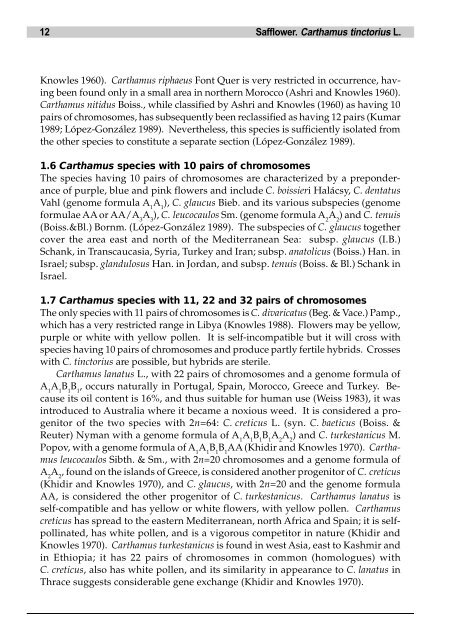Safflower, Carthamus tinctorius L. - Bioversity International
Safflower, Carthamus tinctorius L. - Bioversity International
Safflower, Carthamus tinctorius L. - Bioversity International
You also want an ePaper? Increase the reach of your titles
YUMPU automatically turns print PDFs into web optimized ePapers that Google loves.
12 <strong>Safflower</strong>. <strong>Carthamus</strong> <strong>tinctorius</strong> L.<br />
Knowles 1960). <strong>Carthamus</strong> riphaeus Font Quer is very restricted in occurrence, having<br />
been found only in a small area in northern Morocco (Ashri and Knowles 1960).<br />
<strong>Carthamus</strong> nitidus Boiss., while classified by Ashri and Knowles (1960) as having 10<br />
pairs of chromosomes, has subsequently been reclassified as having 12 pairs (Kumar<br />
1989; López-González 1989). Nevertheless, this species is sufficiently isolated from<br />
the other species to constitute a separate section (López-González 1989).<br />
1.6 <strong>Carthamus</strong> species with 10 pairs of chromosomes<br />
The species having 10 pairs of chromosomes are characterized by a preponderance<br />
of purple, blue and pink flowers and include C. boissieri Halácsy, C. dentatus<br />
Vahl (genome formula A 1 A 1 ), C. glaucus Bieb. and its various subspecies (genome<br />
formulae AA or AA/A 3 A 3 ), C. leucocaulos Sm. (genome formula A 2 A 2 ) and C. tenuis<br />
(Boiss.&Bl.) Bornm. (López-González 1989). The subspecies of C. glaucus together<br />
cover the area east and north of the Mediterranean Sea: subsp. glaucus (I.B.)<br />
Schank, in Transcaucasia, Syria, Turkey and Iran; subsp. anatolicus (Boiss.) Han. in<br />
Israel; subsp. glandulosus Han. in Jordan, and subsp. tenuis (Boiss. & Bl.) Schank in<br />
Israel.<br />
1.7 <strong>Carthamus</strong> species with 11, 22 and 32 pairs of chromosomes<br />
The only species with 11 pairs of chromosomes is C. divaricatus (Beg. & Vace.) Pamp.,<br />
which has a very restricted range in Libya (Knowles 1988). Flowers may be yellow,<br />
purple or white with yellow pollen. It is self-incompatible but it will cross with<br />
species having 10 pairs of chromosomes and produce partly fertile hybrids. Crosses<br />
with C. <strong>tinctorius</strong> are possible, but hybrids are sterile.<br />
<strong>Carthamus</strong> lanatus L., with 22 pairs of chromosomes and a genome formula of<br />
A 1 A 1 B 1 B 1 , occurs naturally in Portugal, Spain, Morocco, Greece and Turkey. Because<br />
its oil content is 16%, and thus suitable for human use (Weiss 1983), it was<br />
introduced to Australia where it became a noxious weed. It is considered a progenitor<br />
of the two species with 2n=64: C. creticus L. (syn. C. baeticus (Boiss. &<br />
Reuter) Nyman with a genome formula of A 1 A 1 B 1 B 1 A 2 A 2 ) and C. turkestanicus M.<br />
Popov, with a genome formula of A 1 A 1 B 1 B 1 AA (Khidir and Knowles 1970). <strong>Carthamus</strong><br />
leucocaulos Sibth. & Sm., with 2n=20 chromosomes and a genome formula of<br />
A 2 A 2 , found on the islands of Greece, is considered another progenitor of C. creticus<br />
(Khidir and Knowles 1970), and C. glaucus, with 2n=20 and the genome formula<br />
AA, is considered the other progenitor of C. turkestanicus. <strong>Carthamus</strong> lanatus is<br />
self-compatible and has yellow or white flowers, with yellow pollen. <strong>Carthamus</strong><br />
creticus has spread to the eastern Mediterranean, north Africa and Spain; it is selfpollinated,<br />
has white pollen, and is a vigorous competitor in nature (Khidir and<br />
Knowles 1970). <strong>Carthamus</strong> turkestanicus is found in west Asia, east to Kashmir and<br />
in Ethiopia; it has 22 pairs of chromosomes in common (homologues) with<br />
C. creticus, also has white pollen, and its similarity in appearance to C. lanatus in<br />
Thrace suggests considerable gene exchange (Khidir and Knowles 1970).

















